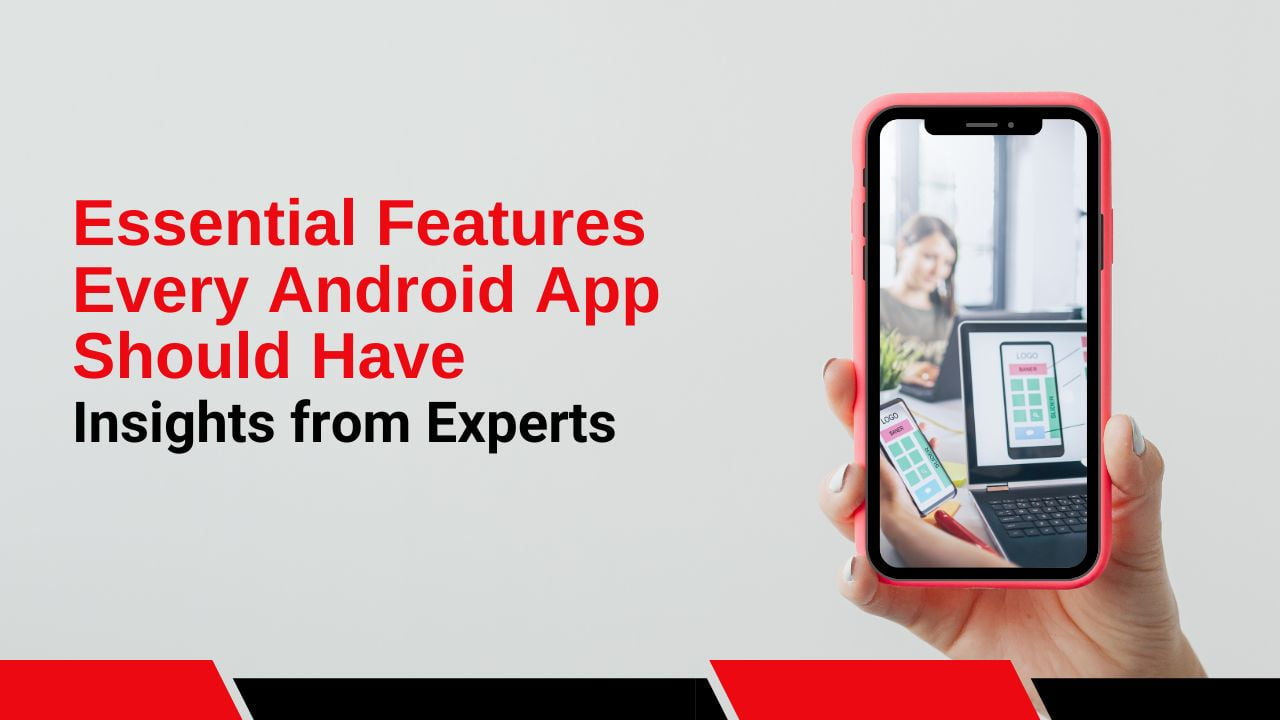The Android operating system dominates the mobile landscape, boasting over 2.8 billion active users globally. This vast user base makes Android app development a lucrative venture for businesses. However, creating a successful Android app goes beyond just functionality. It requires careful consideration of features that enhance user experience (UX) and keep users engaged.
Here, we explore essential features that, according to Android app development experts, should be incorporated into every Android application:
1. Intuitive User Interface (UI) and User Experience (UX)
An app’s UI and UX are the cornerstones of user engagement. Here’s what experts emphasize:
- Simplicity and Consistency: The UI should be clean, uncluttered, and follow Google’s Material Design guidelines for a familiar and intuitive experience. Ensure consistent layout and navigation patterns across all screens.
- Clear and Concise Communication: Use clear and concise language throughout the app. Avoid technical jargon and ensure error messages are informative and actionable.
- Responsiveness and Performance: The app should be responsive to touch gestures and provide smooth performance. Optimize for various screen sizes and devices to ensure a seamless experience across different Android versions.
- Expert Insight: According to UX Planet, 70% of users abandon apps due to poor UX. Investing in a well-designed UI and UX is crucial for user retention.
2. Seamless Integration with Android Features
Leveraging built-in Android features enhances functionality and user convenience:
- Location Services: Integrate location services when appropriate, allowing users to find nearby stores, receive location-based recommendations, or check in to places. Ensure clear communication regarding location data collection and usage.
- Notifications: Use notifications strategically to inform users about important updates, promotions, or reminders. Avoid notification overload – only send relevant and timely notifications with user consent.
- Offline Functionality: Provide core functionalities even when users are offline. This could involve caching data locally or enabling features that don’t require an internet connection.
- Consider this: A study by Forrester reveals that 73% of smartphone users prefer offline apps. Offline functionality improves user experience in areas with poor internet connectivity.
3. Security and Data Protection
Building trust with users requires robust security measures:
- Secure Data Storage: Implement secure data encryption practices to protect user information like login credentials and personal data. Adhere to relevant data privacy regulations.
- Authentication and Authorization: Enforce strong authentication mechanisms like two-factor authentication for user accounts. Implement authorization controls to restrict access to sensitive data based on user roles.
- Regular Security Updates: Maintain the app by addressing security vulnerabilities promptly. Provide regular updates to patch security holes and improve overall app security.
- Important to Note: A report by App Annie indicates that 62% of users uninstall apps due to security concerns. Prioritizing security demonstrates respect for user privacy and builds trust.
4. Performance Optimization and Speed
Fast loading times and smooth performance are essential for user satisfaction:
- Code Optimization: Write clean and efficient code to minimize resource consumption and ensure smooth app performance. Use appropriate libraries and tools for code optimization.
- Image Optimization: Optimize image sizes and consider using lazy loading techniques to reduce initial load times—balance image quality with file size for optimal performance.
- Regular Testing: Conduct performance testing throughout the development lifecycle to identify and address bottlenecks that might slow down the app.
- Statistic to Consider: Studies by Google show that a 1-second delay in mobile page load time can lead to a 7% decrease in conversions. Fast loading times are crucial for user engagement.
5. Adherence to Google Play Store Guidelines
Publishing your app on the Google Play Store requires adherence to its guidelines:
- Content Guidelines: Ensure your app’s content complies with Google Play Store’s policies regarding privacy, intellectual property, and appropriate content.
- App Quality Standards: Meet Google’s app quality standards related to functionality, performance, stability, and security. Google reserves the right to remove apps that don’t meet these standards.
- App Store Optimization (ASO): Optimize your app listing with relevant keywords, clear descriptions, and high-quality screenshots to improve discoverability within the Play Store.
- Expert Opinion: A survey by Clutch reveals that 63% of mobile app developers consider app store optimization a crucial factor for app success. ASO ensures your target audience can easily find your app.
Building Beyond the Basics: Additional Considerations
While the features mentioned above are fundamental, consider these additional points for a well-rounded Android app:
- Accessibility: Make your app accessible to users with disabilities by following accessibility guidelines and incorporating features like screen readers and text magnification.
- Analytics and Crash Reporting: Integrate analytics tools to track user behavior and app performance. Implement crash reporting to identify and fix bugs quickly, ensuring a smooth user experience.
- Push Notifications: As mentioned earlier, push notifications deserve further consideration. Use them strategically to send targeted messages based on user preferences and behavior. Personalization can enhance user engagement and drive conversions.
- Offline Functionality (expanded): Consider offering progressive web app (PWA) functionality. PWAs allow users to add the app to their home screen and access basic features even when offline. This provides a more native app-like experience.
- Multilingual Support: If you target a global audience, consider offering multilingual support. This can significantly increase your app’s reach and user base.
- In-App Purchases: Ensure a secure and user-friendly payment gateway if your app offers premium features or in-app purchases. Provide clear descriptions of what’s included with each purchase option.
- Social Sharing: Integrate social sharing features to allow users to share content with friends and family on social media platforms. This can organically promote your app and attract new users.
Conclusion
Developing a successful Android app requires a blend of functionality, user experience, and technical considerations. By incorporating the essential features discussed by experts and considering these additional points, you can create an Android app that stands out in the crowded marketplace. Remember, a well-designed and user-friendly app attracts users, fosters brand loyalty, and drives business growth.
Partnering with an experienced Android application development company can be a strategic decision for businesses seeking to navigate the complexities of Android app development. These companies possess the expertise to design, develop, and deploy high-quality, feature-rich Android apps that meet your specific business objectives.






Tech content on this site may include contributed articles and partnerships with industry voices. Learn more in our Editorial Policy.